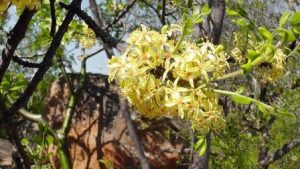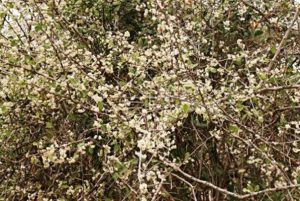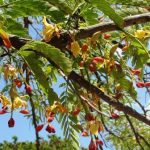TREE LIFE
August 2000
WHILE THE PRESENT PROBLEMS PERSIST PLEASE CHECK WITH ANY OF THE COMMITTEE MEMBERS TO ENSURE THAT THE SCHEDULED OUTINGS AND WALKS WILL ACTUALLY TAKE PLACE.
MASHONALAND CALENDAR
Saturday 5 August. Our Botanic Garden Walk is cancelled for two months. We wish Tom a speedy recovery and we look forward to our next walk in October. In the meantime let us know if there is anything you would particularly like Tom to show us.
Sunday 20 August. Mrs. Mick Fleet in the Umwindsidale area has kindly offered her property for our next outing. Meg Coates Palgrave will be stepping in to lead as our usual leaders will be in UK. Bring your lunch and a chair and meet at the home¬stead at 9.30 a.m.
Saturday 26 August. Mark will be away so no walk this month.
Saturday 2 September. No Botanic Garden Walk.
MATABELELAND CALENDAR
Sunday 6 August. To an area near Mazwi Nature Reserve (Khami area). Meet in the car park at Girls’ College for a prompt departure at 8.30 a.m.
Sunday 3 September. Possibly a tree naming exercise on NUST campus.
BUBI RIVER: April 18 – 23rd 2000
Tuesday, April 18
We travelled down on Independence Day via Masvingo and arrived at Three Ways Safari camp in the afternoon. The camp is on the southern bank of the Bubi River, c.8km E of the main road bridge on the Masvingo/Beitbridge Rd.
Although the camp is 6 metres above the sandy river bed, the water had risen 8 metres at its height, submerging the camp to just below roof height. Damage was extensive.
The traditional pole and dagga huts were mostly still standing but with poles only while the more substantial buildings had generally been swept away. However, the kitchen and 2 huts had been refitted and a tent put up – no ground sheet but real beds – and rebuilding was going on.
We (the Hydes) are hardy and we were going to camp – until we discovered that after our last trip our tent (like the Red Sea) had divided into 2 parts and we only had the fly sheet. We might have given the stars a go except for the fact that there was still rain around. So we bagged one of the washed-out huts and so had a room with a view on all sides through the poles.
Right up to the last few days, many doubts and fears had been raised about this trip, possibly the most serious being the fuel shortage which had been so bad in March; the possibility of marauding war veterans (we checked with the CFU before leaving) and, not least, the very severe damage which had been done to the camp. Luckily, we were able to leave Harare with the two tanks of our Landcruiser full (180l in all) and we managed to get diesel (or at least some) in both Chivhu and Masvingo. After a few days, diesel became available at the Bubi village and we were able to fill up every morning.
Seven of us came down from Harare (Maureen, Rose, Andy and 4 Hydes) and we were joined by Jonathan Timberlake and son, Tom, aged 7 from Bulawayo. Later, Adele Hamilton-Ritchie joined us with a friend on the way back from South Africa.
-Mark and Linda Hyde
Wednesday, April 19
The first day was spent locally as Mark wanted to try and find a plant recorded from by the railway bridge. This is an exotic “gooseberry”, Physalis viscosa, which was discovered by Bob Drummond some years ago. We therefore found the service road along the railway line and headed down this (knowing the railway line was still closed due to bridge problems on the South African side). Unfortunately the road was still transected by a large murky pond from which acacia bushes rose like green boats. We therefore took to our feet and walked along the railway line.
Jonathan showed us Acacia tortilis subsp. heteracantha and explained the differences between the two subspecies. The morphological differences are that heteracantha has pods in tighter coils than does spirocarpa and its pods lack the fine red glands on the pods which spirocarpa has. Ecologically, heteracantha occurs in generally disturbed habitats and is often found away from rivers; it is the usual subsp. in the south and west of Zimbabwe, whereas subsp. spirocarpa is the common one in the north and is usually associated with rivers.
Linda then took the boys walking along the Bubi River bed towards the Lion and Elephant. The river still had water flowing in it, water so clear that from 40 feet up on the bridge schools of small fish could be seen darting about in the deep furrows scoured by water upstream of the pylons. Being a seasonal sand river they were free from fears of hippo, croc and bilharzia and so could enjoy the walk more than some of the trails in the Zambezi Valley. They floundered in mud up to our knees, padded quickly across hot sands, marvelled at the height of the banks, watched the grains of sand tumble down stream, identified to the best of our imagination foot prints and created tracks where no man since the flood had walked before. It took them just over 2½ hours to do just over 1km.

Pergularia daemia. Photo: Bart Wursten. Source: Flora of Zimbabwe
The vegetation along the railway line and by the river was typical of low or medium altitudes (Colophospermum mopane, Croton megalobotrys, Faidherbia albida, Grewia bicolor, Hyphaene sp., Justicia flava, Pergularia daemia and Schmidtia pappophoroides) with a noticeable weedy component (e.g. the two grasses: Cenchrus ciliaris and Pennisetum setaceum). A very striking tall grass with an apical cluster of whitish racemes was seen which was new to me – this turned out to be Chloris roxburghiana. Two species of Commicarpus were found – both the fairly common Commicarpus plumbagineus and the rarer (and new to me) Commicarpus pilosus.
However, there was no sign of the Physalis so we drove round to the Lion and Elephant to await Linda and the boys. Near the some¬what damaged road bridge, some fine specimens of Flaveria bidentis were found. Two species of Flaveria occur in Zimbabwe; both are exotic and hail from tropical America, the commonest one seen generally, including around Harare, is Flaveria trinervia whereas Flaveria bidentis appears to be confined to the southern division.
In the afternoon, we parked the cars by the road into the camp and walked up a low hill. The vegetation here was very different to the alluvial stuff around the camp. Trees seen included: Adansonia, the ubiquitous Colophospermum mopane, Combretum apiculatum, Commiphora africana and Commiphora glandulosa, Gardenia resiniflua, Kirkia acuminata, Lannea schweinfurthii, Ochna inermis, Ptaeroxylon obliquum.

Ptaeroxylon obliquum. Photo: Brian Orford. Source: Flora of Zimbabwe
A spiny shrub defeated us and there was much debate as to what it was. We finally settled tentatively for the var. natalensis of Ximenia caffra. However, this turned out to be quite wrong – it was in fact Maytenus putterlickioides, a species we had hoped to see for many years but had never done so. Botanical opinion nowadays is to put the spiny species of Maytenus into Gymnosporia, so this would become Gymnosporia putterlickioides.

Gymnosporia putterlickioides. Photo: Mark Hyde. Source: Flora of Zimbabwe
The ground flora was also of great interest. A yellow-flowered succulent sp. with prostrate stems was determined as Portulaca collina and may be new to the S division. Very common was a low shrubby Acanthaceae with long red corollas – Anisotes rogersii. A tall, striking parasitic Scrophulariaceae with purple flowers and purplish stems was Striga gesnerioides.
Fairly common throughout the area and seen frequently on other days was a herbaceous Euphorbiaceae covered in stellate hairs, Cephalocroton mollis.
Back at camp, the boys and Linda took their lives in their hands – or so it seemed – and swung on the swing. A long rope tied high above the river to a “Rain Tree” – Philenoptera violacea (Lonchocarpus capassa) – the bottom was a large loop into which you put one foot and swung out over the river bed – a 5-second trip which seemed to last for hours and would beat anything Disney had to offer in Swiss Family Robinson.
-Mark and Linda Hyde
Thursday, April 20
On the Thursday, en route to Chiturapadzi to try and track down the infamous, elusive Triceratella drummondii, we stopped off to look at the south-eastern foot-slopes of Marungudzi “mountain”, situated at the edge of Diti communal land and Kayansea commercial ranch east of Beitbridge. Marungudzi, considered sacred by the local Venda population such that one needs chiefly dispensation to climb it, rises abruptly from the generally flat low mopane woodland around. When the sun is right, one can see the rocks glinting pinkish showing that the upper part of the hill is composed of quartz syenite, the same rock that forms much of the nearby Mateke hills, the Hillside area of Bulawayo South and Mt Mulanje in Malawi. In fact, the Marungudzi “alkali ring complex” is well known geologically and is almost unique in the country. It is said to have been intruded around 190 million years ago and contain various rare minerals, although none of economic interest.
However, what we had come to see was the area of black cracking clay soils to the southeast of the hill. These were very clearly visible on the satellite images we had and appear different from other, more common areas of black clay soils associated with another rock type, basalt. Careful study of both satellite image and geological maps suggested that these soils were possibly derived from a base-rich igneous rock called Gabbro, which is rare in Zimbabwe. In south-eastern Botswana black cracking clays derived from Gabbro support such low shrubby Acacia species as Acacia tenuispina and others of the so-called “glandular complex”. We wanted to see if this, or other species adapted to these nutrient-rich (in both calcium and magnesium) but difficult soils, were present.
Clay soils composed of montmorillonitic clay minerals, sometimes termed black cotton soils, have a distinctive attribute of being “self-churning” or “self-mulching”. When dry they crack to a depth of quite a few centimetres, into which organic matter falls or is blown. With the onset of the rains, water pours into the cracks and the soil swells, incorporating the humus. Very difficult soils to plough – like cement when dry and terribly sticky and heavy when wet. And also very difficult for woody plants. The alternate drying out followed by strong churning forces on swelling shear the roots of most woody plants. This “self-pruning” means that only those species with strong tough roots – such as some Acacia species (particularly Acacia nilotica and some members of the glandular complex), Dichrostachys, mopane and Dalbergia melanoxylon – can survive. And even they are generally stunted as the roots cannot penetrate deeply. Grasses, being very shallow-rooted (usually only extending down 10-20 cm), survive well. Such soils also support many leguminous herbs. But in general these cracking-clay areas are species-poor, particularly as regard the woody flora.
What we found at Marungudzi was an area of fairly shallow black to dark brown cracking clay, but not as black or cracking as we expected or like the “sidaga” grasslands of N Gokwe and Busi. The patch formed a cap on top of an almost-imperceptible rise, whereas normally clay soils are found in depressions. The vegetation was low mopane woodland, 2 to 4 m’s in height, with more open patches where the soil was thinner owing to outcropping rock. Scattered trees of mopane and Lannea schweinfurthii were noted on what appeared to be old eroded termitaria. There was a lot of shrubby Dalbergia melanoxylon, although not of sufficient size to make an ensemble of clarinets (just piano keys!), and Acacia borleae with its sticky young growth, wavy-edged curved pods and glandular leaflets. Many of the grasses were annuals such as Enneapogon, Aristida, Urochloa and Setaria. There were a number of leguminous herbs, but we were too late in the season to see any evidence of the bulbous species often found in this habitat type. No Acacia tenuispina though (which would have been another first record for Zimbabwe) and no other specialized acacias other than the fairly widespread lowveld Acacia borleae.
Mark collected a Compositae herb which has been determined by Bob as Launaea intybacea. There is no record of this species for Zimbabwe in either the National Herbarium or in Flora Zambesiaca and it therefore appears to be a new record for Zimbabwe.
So, not quite the habitat we had originally envisaged, but none-the-less interesting, and a change from the surrounding mopane on gneiss and gravelly/stony soils. Perhaps with more time, and an opportunity to climb the geologically fascinating and diverse Marungudzi hill, we would find a lot more of interest.
-Jonathan Timberlake
Thursday, April 20, continued:
We then travelled further, along the surprisingly good road to Chiturapadzi. The great interest here is the annual herb Triceratella drummondii, found new to science by Bob Drummond in 1958. An attempt was made in February 1997 in the company of Bob Faden, the expert on Commelinaceae, to re-find this – see Tree Life 205, March 1997 – but this was unsuccessful.
Since then, a single plant of Triceratella has been found by a botanist doing an Environmental Impact Assessment at a mining site near the coast in Mozambique. Unfortunately, only a single plant was grabbed: no-one was aware until later of its significance and there was no chance to get the species into cultivation in order to count its chromosomes and examine its DNA.
Once again, we were not successful in finding the Triceratella, but Chiturapadzi is a wonderful site botanically anyway and this year a lot of water was seeping out of the hillside near the base creating a rich habitat of seepage zones and small ponds, filled with sedges and other annual herbs.
Three of these were of great interest to me: Exacum oldenlandioides, a small herb in the Gentian family with opposite leaves and blue flowers; Bacopa floribunda, a small Scrophulariaceae with white and brown flowers and Portulaca kermesina, a succulent with reddish flowers. Maureen also found a striking climbing Cucurbitaceae, Cucumis myriocarpus, which has spherical fruits with brown and white stripes. In the woody flora, a specimen of Grewia hexamita was found together with an unknown Vitex.
Our journey home was made shorter by taking farm tracks. Some interesting jog-stops (stops at which plant people browse and the rest of us jog on up the road to be collected as and when the others come on in the car) on the way resulted in us finding Rhigozum zambesiacum. Unfortunately the specimen was lost and we needed to devote part of a later day to re-finding it.
-Mark and Linda Hyde
Friday, April 21
A local day spent labelling trees around the camp in the morning. The banks of the Bubi show considerable damage with many large fallen trees and much mess caused by piled up branches and shrubs. The ground in the riverine vegetation was generally bare but was quickly recovering and various annual herbs (such as Argemone mexicana, Blumea viscosa and Datura innoxia) were beginning to appear.
The riverine forest consisted of: enormous Acacia galpinii, Acacia nigrescens, Acacia schweinfurthii, Acacia xanthophloea, Berchemia discolor, Combretum imberbe, Combretum mossambicense. Commiphora glandulosa, Croton megalobotrys, very large Diospyros mespiliformis, Faidherbia albida, Ficus sycomorus, Grewia bicolor, Grewia flavescens var. flavescens, Philenoptera violacea, Spirostachys africana. The large woody climber Cocculus hirsutus was also frequent.
In the afternoon we were offered a trip along the river with “Tokkie”van der Merwe in the back of his open Landrover. It was a road that wound through Mopane, acacia and thick riverine woodland which the floods had covered. Tokkie needed to check the road out before well-heeled American tourists arrived for the hunting season. One incongruous item of debris was a plastic dustbin (40-gallon size) which had landed the right way up in the middle of the road and subsequently filled with rainwater.
The skies darkened as we headed for home. Rain in the southern lowveld is very different from the warm Zambezi Valley – it is COLD. Clad only in shorts and shirts on the back of an open Landrover we pulled our hats well down to protect eyes and cheeks – not from acacia branches but from the hail-like rain. The half-hour race back over the now slippery black, mud was a dramatic contrast to the idyllic earlier part of the day. Shivering we stripped off before entering the room-with-a-view where, wrapped in towels, we waited in line for 2 minutes in the hot shower by candle light. That evening we all wore 2 layers of clothing plus jackets – not something you expect in the lowveld even in April.
-Mark and Linda Hyde
Saturday April 22
The following day Mark braved the mud causeway back to the main road, although for at least ½ of this stretch the car edged crab-wise towards its destination. We found that diesel had been delivered to the main road garage overnight so the trip to the Mateke Hills was ON. North this time and then eastwards towards a granite plateau rising some 300 feet above the flat lowveld plains. Unfortunately we took a wrong turning and ended up running northwards along the edge instead of plunging into the middle of the hills. The road was very wet & the problem was compounded by the fact that it was also used as a cattle track. We finally balked at trying to cross a cattle pen with a fence on one side and thick mud (probably thixotropic) on the other and no sign of roads onto the plateau.
A lunch stop was followed by a scramble through some of the worst Aristida and Burr fields I have seen and the tantalizing view from the top confirmed the “real” hills were still to the east. On the way back we stopped at a small outlier kopjie dose to the Sheba Ranch homestead – mostly rock & scrambling creepers with trees of various sizes poking through the granite (we had passed it 3 hours before and ignored it). Here, stamping hard on the rock to scare away snakes, we scrambled again to the top. This time we were rewarded with interesting plants (a small Pavetta – possibly Pavetta incana, also recorded from Marungudzi: the wild cotton – Gossypium herbaceum, var. africanum and a species of Barleria (Barleria affinis), covered in stellate hairs). From the top, we had a 360° view of the hills to the north and the plains stretching south to the Bubi and beyond.
This time we were headed home in the twilight and the dark and were rewarded by the sight of giraffe, caught in our headlights on the road. This followed by an enormous spider web which had been spun in the last 12 hours and spanned the road to a height of 12 feet. Unfortunately we had to break it to get to camp but I am sure that a more successful web would be spun in the bush the next day.
-Linda Hyde
Easter Sunday, April 23
The day started very leisurely, everyone doing their own thing. Midmorning some of us took a drive along a gravel road to look for a particular shrub we had seen several evenings ago from a previous drive. We drove 3 or 4 kilometres, and then did some walking. Maureen was strolling with me, so helped me identify most of what we saw.

Grewia bicolor. Photo: Mark Hyde. Source: Flora of Zimbabw
Dalbergia melanoxylon – the Zebrawood. It is a fairly small shrub-like tree, which was full of pods.
Grewia bicolor – False Brandy bush, a lowveld shrub.
Acacia nigrescens – Knob Thorn. The largest leafed acacia which the giraffes love, a fairly large tree.
Dichrostachys cinerea – Sickle Bush. Very hard wood, the roots are used for medicinal purposes.
Combretum apiculatum – Red Bush Willow, very hard wood, good for making coals for cooking. Leaves are very nourishing and eaten by many wild animals and domestic stock.
Commiphora mollis – Soft-leaved Commiphora browsed on by game and domestic stock.
Terminalia prunioides – Purple Pod Terminalia, fruit is very striking in autumn.
Grewia flavescens – Donkey Berry. Small shrubby tree with square stem.
Colophospermum mopane – Dominant over great areas in the lowveld.
Back in the vehicle we saw Adansonia digitata – the Baobab tree.
Ormocarpum trichocarpum – Large Caterpillar Pod. The fruit resembles a small fat hairy caterpillar.
Two very striking “morning-glories” climbing on the shrubby vegetation were collected. One had pale yellow flowers with a dark centre which was determined by Bob as Merremia kentrocaulos var. pinnatifida; the other had smaller purple flowers and was Ipomoea magnusiana.
At last we spotted the mystery shrub – Rhigozum zambesiacum – Mopane Pomegranate, it has lovely golden yellow flowers.
-Rose Greig
In the afternoon, some of us took the Landcruiser and drove following Tokkie’s instructions along a fence line and up to a small hill with a Baobab on it. On the way, we stopped in a grove of Rhigozum zambesiacum. This is a distinctive species with small pinnate leaves each with tiny pinnae. An interesting spot-character for this species which I had not realised before was that the rhachis is winged. The same site saw further material of Acacia grandicornuta. Jonathan explained that this is usually a riverine species but here it was clearly not. To me it looked a bit like Acacia karroo (Jonathan mentioned the interesting fact that Acacia karroo rarely occurs at such low altitudes – hardly ever below 600m and here we were at c.500m). But in any case the pods are different – those of grandicornuta resemble those of robusta or young Acacia gerrardii. At our last stop, we found a shrubby Croton, which looked distinctly different to Croton gratissimus and indeed it turned out to be Croton pseudopulchellus.
The next day (Easter Monday – 24th) we left at the crack of dawn for an uneventful drive back to Harare.
Tailpiece and thanks
Our great thanks to Tokkie and Rinie for being such marvellous hosts for the 5 days and for encouraging us to come, for providing help and advice and for lending us a GPS.
Our thanks also go to Jonathan for shedding so much ecological and geological insight into what we saw and to Andy for organising the trip. Thanks also to Bob Drummond for naming nearly everything we collected. A complete list of the plants collected is available from me on a spreadsheet if anyone is interested.
-Mark Hyde
THE MARULA AT KILOMETRE 111
The Marula, Sclerocarya birrea subsp. caffra, is a common tree of the lower-altitude, hotter parts of Zimbabwe, and one would not expect to find large-sized specimens on the highveld. But trees are full of surprises.
Between Km 111.0 and 111.5 on the highway from Harare to Masvingo, there is a large Marula about 20 metres off the road on the west side. It is open country here, at an altitude of about 1390 metres, and night-time temperatures in winter must often be close to freezing, or even lower, yet this tree has reached near maximum size for the species in this country. In March 1986 it had a height of 13.8 metres, a diameter of 1.09 metres, and a crown spread of 15 metres. The stem forks at a height of 80 cm above ground level, and the diameter measurement was made at the narrowest part below the fork.
Marula wood is a bit lighter than Mukwa, a pale pinkish colour, and without any figure to it, but with judicious staining it can be made into very presentable furniture. Seasoning can be difficult if the wood is dried too quickly, but with proper handling it has great utility value. The well-known fruits are very palatable to humans and animals, and it is in this field that the tree’s greatest value lies, although it also features in local medicine and magic. The species occurs at least as far north as Kenya.
-Lyn Mullin
In Retrospect —WEDZA MOUNTAINS AND THE NICKEL ANOMALY
In preparation for a Tree Society visit to the Wedza Mountains on 19 July 1981, TREE LIFE No. 16 (July 1981) carried two notes that are worth reproducing in full:
WEDZA MOUNTAINS
Our July outing will be to the Wedza Mountains; the last visit by the Society was 10 years ago. And as this is an area of great interest, we thought everyone would like to know a bit more about it, even those who will not be able to join us on the trip.
The Wedza Mountains are situated 60km south of Marondera, and 60km west of Nyazura, and are approximately 11km south of Wedza village (23km by road). The range lies with its long axis in a NE-SW direction, has a length of about 21km, and is 5km wide at its widest. Much of the mother rock is serpentine capped with banded ironstone, which, being very hard, explains why, over the past 300 million years, the massive rock has remained behind while the surrounding countryside has eroded away. The mountains are divided into 3 separated physical entities. The northern area, Dowa, reaches an altitude of 1 402 m, and is separated from the central area, Romorehoto, by the Nyamidzi River, which then runs down the valley to the east of the mountains into the Save River, of which it is, at this stage, a major tributary. The Save flows round the southern end of the southern section, known as Gandamasunga, which rises about 400 m above the general level of the countryside, and is separated from the central mountain by the Gandamasunga Gap. It is in the area near the gap that the old Adzwe gold mine was situated, which was founded on extensive ancient work¬ings for the Gold Fields Rhodesian Development Company Ltd., and worked between 1925 and 1939. The central section, known as Romore¬hoto, is the highest area, rising about 450 m above the land on both sides, and about 640 m above the Save River. Here, the mountain is 5km wide, and has two peaks – Romorehoto (1760 m), joined by a saddle to the highest point, Dangamvuri (1791 m), on which there was a police radio post during the bush war. On the eastern side, below the saddle, is an old scheelite mine.
The dominant vegetation is Brachystegia type woodland: Brachystegia boehmii on the gentle middle and lower slopes; Brachystegia glaucescens on the steeper slopes, and Brachystegia spiciformis, which are, like those at Nyanga, rather stunted and covered in old man’s beard, usually occurring where there are mists. The most interesting trees that occur here are those that are also found in the Eastern Highlands forests, and grow mainly along streams and in gullies where there is plenty of moisture. Although there is a normal summer rainfall of about 965mm at Wedza itself, there are no records for the mountain. However, a lot of extra precipitation must occur because the mountains stand so much higher than the surrounding land, and during the winter there are often days of “guti” over the mountains. And this has undoubtedly enabled the Eastern Highlands forest-type vegetation to survive – perhaps a reminder of a past age when the climate was colder and wetter, and evergreen forests connected this area to the Eastern Highlands.
We did a brief trip on one of those “guti” days, and stopped at the stream at the bottom of the central section, on which the little Nyamatonora Dam is situated. Ferns and moss and fascinating fungi abounded, and, in the short time we were there, we found Bridelia micrantha (mitzeeri) and Rhus natalensis (Natal Rhus, which I have not collected before), in addition to several other forest species, including Diospyros whyteana (bladder-nut). Conversely, some areas on the Wedza Mountains are bare and stunted, not because the vegetation has been chopped out, but because the soil contains concentrations of nickel, and I can do no better than repeat Chris Lightfoot’s article in the Newsletter of June 1970. He refers specifically to the area of the Gandamasunga Gap.
THE NICKEL ANOMALY
An area such as this, where vegetation differs markedly from surrounding associations, is known as an anomaly. Nickel is thought to be the heavy metal most toxic to plant growth, followed by copper. Moreover, the effects of this toxicity are manifested in the vegetation in different ways on copper and nickel soils. Professor Wild, of the University’s Botany Dept, has recorded a total of 436 species occurring in copper soils throughout Zimbabwe, and only 302 on nickel soils. Numbers on each particular anomaly are, of course, far less. On the very strong one near the old Wedza Mine, for example, a total of only 17 species of grasses, herbs, and trees has been found.
Thus, a very reduced number of plant species can immediately indicate the presence of heavy metal in the soil. The species themselves give a further indication. On the Wedza anomaly, in an area surrounded by common Msasa/Mufuti woodland, the dominant tree is stunted Combretum molle (velvet-leaved Combretum). Suspicions are further confirmed by the presence of the soft, woolly herb, Dicoma macrocephala, in numbers in the area, since a form or perhaps a subspecies of this plant seems to be found only on nickel soils in Zimbabwe, [and has] earned the name “nickel flower”. This, and other, plants have the ability to take up nickel, which is of no use to them, and remain unaffected. Analysis of the leaves of such plants for heavy metals forms the basis for “bio-geochemical prospecting”. This method is presently being employed using vegetation on the wind-blown Kalahari sands to determine whether the underlying rocks contain economic minerals.
On this trip we will only be able to examine a tiny part of these huge mountains, which vary so much in all their aspects. Perhaps this should be the beginning of a series of visits. There is a move to have the Wedza Mountains declared a Nature Reserve, and if this happens it could become more accessible, which would certainly make future trips easier.
[Comment 2000: An account of the visit to Wedza Mountains was published in TREE LIFE No.18 (August 1981), and included a very useful map of the area, plus a list of more than 100 tree species recorded. Another visit to Wedza Mountains was made by the Tree Society on 19 October 1986, and the notes on this visit, which expanded somewhat on the geology of the area, were published the following month in TREE LIFE No.81.]
RHACHIS vs. RACHIS
Rhachis/rachis refers to (1) the main axis of an inflorescence, and (2) the axis of a pinnately compound leaf to which the leaflets are attached. OK, but do you spell it rhachis or rachis? The Penguin publication, A Dictionary of Biology, by M Abercrombie, CJ Dickson, and ML Johnson (1965), has it as rachis. Collins English Dictionary (1979) has it as rachis, with rhachis as a variant spelling.
A Dictionary of the Flowering Plants and Ferns, by JC Willis (1951), has rhachis first and rachis second. The Plant Book, by DJ Mabberley (1993), does not mention either. The Woody Plants of Natal and Zululand, by JS Henkel (1934), has rhachis. The Complete Field Guide to Trees of Natal Zululand & Transkei, by Elsa Pooley (1993), has rachis. And Brian Best and Paul Coates Palgrave gave their considered opinions in TREE LIFE No.27 (May 1982):
There is no doubt that, correctly, it should be spelt rhachis, but has been used so commonly without the first ‘h’ that this has become an equally accepted alternative. In fact, Henderson’s Dictionary of Scientific Names gives all the information under rachis, and looking up rhachis refers you back to it.
William T Steam’s Botanical Latin gives the following fascinating explanation upholding the [rh spelling). In the Greek alphabet a backwards comma above a small letter means that the word originally started with an ‘h’, and is the rough breathing sign (spiritus asper). A small letter with nothing above it indicates the smooth breathing sign (spiritus lenis), and means that the word does not have an ‘h’ in front of it. And I refuse to complicate the issue by explaining the upside-down, back-to-front, inside-out apostrophes and commas that appear in front of the capital letters and which all mean different things. And please note that all the apostrophes, commas, quotes, etc that I have used in this article mean only what they usually mean.
To continue… the small letter sign for ‘0′ or omega, when used in the word ‘oros’, meaning time, has a backwards comma over it, so the word should be ‘horos’, and this is acknowledged in the English words hour, horoscope, horology, etc. The Greek letter ‘r’ is written like a ‘p’ (how difficult can you get?), and when used for ‘rachis’, has a backwards comma over it, which means that it should be hrachis, which, being unpronounceable, becomes rhachis, meaning spine, backbone, ridge. This letter is responsible for words such as rhizome, rheumatism, and rhythm, but has equally been corrupted without the ‘h’ for radish, rose, and rachis. To wax lyrical in the Best fashion:
When learning trees in Greek, ‘H’ forbid,
The mHidrib and the spHine and the bHackbone did
Teach you just enough so that you knew to miss
The first of the Haitches in the re-Hay-chis.
Chorus: My weh!
John Cottrill has rescued a copy of Keith Coates Palgrave’s Trees of Southern Africa.
Although the cover is somewhat puppy-chewed the ‘stuff that matters’ is all there and John is offering it for sale for a mere $300 ($1400 new). If you are interested please contact Maureen Silva-Jones who has the book.
Mr. Lyn Mullin has done a great job compiling a list of Ndebele plant names from three main sources. (1) FL Orpen (1951), Botanical-Vernacular and Vernacular-Botanical Names of some Trees and Shrubs in Matabeleland, which was originally published in the Rhodesia Agricultural Journal, Volume XLVIII, No. 2, pages 165-181, March-April 1951. This was reprinted as Bulletin No. 1573 in the same year. (2) H. Wild (1972) A Rhodesian Botanical Dictionary of African and English Plant Names, revised and enlarged by H.M. Biegel and S. Mavi, and (3) J. Timberlake, C. Fagg, and RD Barnes (1999), Field Guide to the Acacias of Zimbabwe.
The list is available to members for $50 to cover paper and postage, or on a computer disc supplied by yourself, or by e-mail.
Please contact Maureen Silva-Jones.
ANDY MACNAUGHTAN CHAIRMAN



